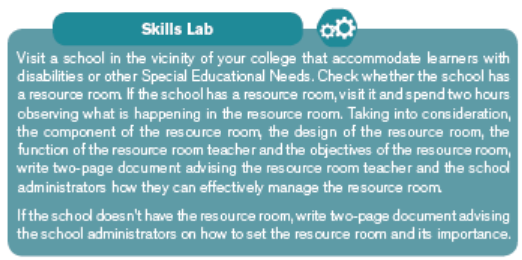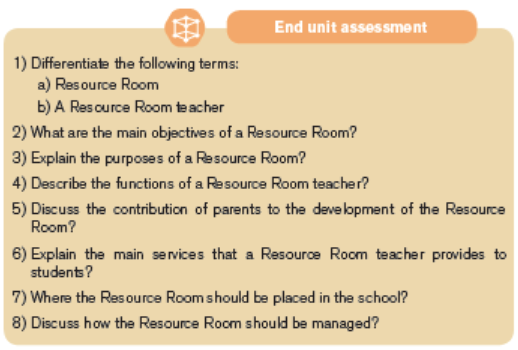UNIT 6: RESOURCE ROOM USE AND PRACTICES
Key Unit Competence:
Students should be able to discuss the components, functions and design
of an inclusive school Resource Room to support teaching and learning forlearners with disabilities and SEN.
6.1. Definition, objectives and component of resources
room
a) Definition of Resource Room
Physically, a resource room is a classroom where students come for part of
their instructional day to receive special education services. These services
may include academic, emotional, welfare, health and other supports as
needed. Services depend on the student’s individual need as outlined in their
IEP and may range from reading, writing or math support to learning social
skills, organizational skills and work completion. This support may be given
individually or in small groups.
b) Purpose and Objectives of the Resource Room
Resource room is both for students who qualify for special education services
or for general education students who need some special instruction in an
individualized or small group setting for a portion of the day. It has following
purposes:
• Learners’ needs are supported in resource rooms as defined by individual
Evaluation Plan of students.
• Students access the educational materials in a manner that better suits
their learning styles and capabilities.
• Students come to the resource room to be better able to focus and take in
the material, especially when new information is being introduced.
• The material taught in the general education classroom is above the
student’s level and the resource room serves as a more serene place where
the student can go over the material at a slower pace.
• The small number of student allows them to focus better, be more engaged,
and understand the materials more easily.
• It has the place where students come to be assessed and tested.
• The resource room provides a less distracting environment and thus a better
chance at success.
• To determine special education eligibility, a child is re-evaluated every three
years, and in most cases, the re-evaluation happens in the resource room
Many resource rooms also support the social needs of their students, as the
small group setting is less threatening, and students who sometimes fall on
the outskirts of the general education classes are more willing to step out of
their comfort zones and make friends. It provides opportunities for behaviour
interventions, and teachers frequently coach students on their social skills,
often by helping them take on leadership responsibilities, such as helping
another student learn. It may also serve as a meeting place for IEP evaluations.
Teachers, paraprofessionals, parents, students, and any legal representatives
typically spend well over 30 minutes discussing the specificities of the student’s
IEP, reporting on how the student is currently doing in all aspects outlined in
the plan, and then revise any sections as needed.
The Resource Room serves the following objectives:
1. Helps learners to benefit from targeted instruction and training while
remaining included in the mainstream classroom for the majority of the
day with their friends and age-mates;
2. Enables learners learn at their own pace and according to their readiness
and needs.
3. Accommodates learners during crisis, emergency or other stressful
occurrences, be these health, physical, social or emotional
4. Provides an environment where the learner can receive counselling and
guidance
5. Provides a location where learners can benefit from additional support
without the stigma associated
6. Provides the school with a flexible resource that enables learners to receive
additional support within the framework of a set academic timetable.
c) Components and Design of Resource Room
A well designed Resource Room should be designed in way that benefits learners
with Disabilities and other Special Education Needs. The Resource Room should
be a place where learners with special needs find help and feel conformable in a
much focused way. It should be enough equipped with specialized and adapted
materials that help the learners improve academically, socially and emotionally.The following are the components of a Resource Room:

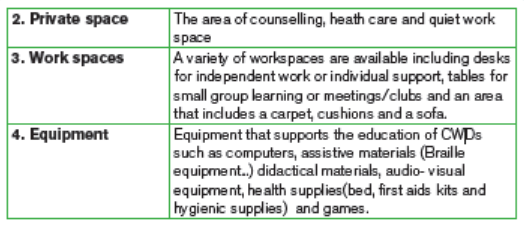

6.2. Functions and services of a resource room teacher
a) Functions of a resource room teacher
A resource room teacher is a specialized educator that focuses on helping
children with Disabilities and other Special Educational Needs in the resource
room. The resource room teacher work closely with the child’s regular classroom
teacher and the parents to ensure the support is indeed helping the student
reach their full potential. The resource room teacher provides the student with
the ways and means to succeed in the regular classroom. The following are the
mains functions of the resource room teacher:
• Provide advice about such issues as how to modify the general curriculum
to help the child learn; the supplementary aids and services that the child
may need to be successful in the regular classroom and elsewhere; how to
modify testing so that the student can show what he or she has learned;
and other aspects of individualizing instruction to meet the student’s unique
needs.
• Helping to write the Individualized Education Plan
• Create schedules and timetables work with the student in a resource room
devoted to students receiving special education services.
• Collaborate with regular education teacher; and work with other school
staff, particularly the regular education teacher, to provide expertise about
addressing the child’s unique needs.
• The resource room teacher provides professional development and training
to teachers, administrators, parents, local leaders and others who provide
services for children with disabilities
b) Services offered in the resource room
Teachers in the resource room have a challenging role as they need to design
all instruction to meet the specific needs of the students they serve to maximize
their learning potential. The following are the usual services provided in a
resource room.
• Assessment and Evaluation services
The resource room team’s first step is to gather specific data regarding
the student’s progress or academic problems. This may be done through a
conference with parents, observation of the student, analysis of the student’s
performance (attention, behaviour, work completion, tests, classwork,
homework, etc.).
• Placement Services
The information collected helps school personnel determine the next step.
The next step would be to check the extent of disability and the services to
be provided to the child. Depending on the needs of the child, his or her IEP
may be carried out in the regular class (with supplementary aids and services,
as needed), in a special class (where every student in the class is receiving
special education services for some or all of the day), or in the resource room.
• Individualized plans
After the team collates their observations; they usually plan an IEP meeting.
The IEP refers to Individualized Education Plan. It guides the resource teacher
in planning lessons and providing appropriate instruction for the child. It spells
out what your child’s special education services will look like on a day-to-day
basis. It is essentially a roadmap guiding the team to provide your child with the
help that he or she needs in order to be successful in school.
• Push-In service
It is educational approach in special and inclusive education where the general
education teacher and the special education teacher work together in close
collaboration. The focus is to ensure students are receiving full access to
the general education curriculum while limiting any disruption to their daily
schedule (such as pulling students out of a classroom). This also includes
the implementation of specially designed modifications within the classroom
setting.
Teachers have to form small groups of two or three students, grouped according
to their level or disabilities. This can help with personalizing the teaching without
sacrificing class instruction time. For example, in Math class, one group could
be working on the basics while a more advanced group could be working on
their geometry skills. Students would be grouped together according to similar
skill levels and objectives along their educational pathway.
• Pull-Out service
A“pull out” system is where a child attends a session in the resource room
during a light period of the day such as singing or physical training, receives
individual help in a weak area of learning such as reading or writing. Methods
and materials are adapted to students’ learning styles and characteristics using
multisensory and other specialized approaches for example, assistance with
completing an exam, progress monitoring and other assignments as assignedby general education teacher and special educational teachers.
6.3. Position, placement and management of resource
room in an inclusive school
A good resource room should have the following traits:
• The physical setting
The resource room should be first and foremost accessible and welcoming
for all users in general and CWDs in particular. The resource room should
be considered as an integral part of the mainstream school. Where possible,
choosing a central classroom location is preferred for easy access and school
community involvement.
• Physical characteristics
The resource room should respect the current standards of school construction
and be housed in a mainstream classroom. If a mainstream classroom is not
available, then a suitable alternative needs to be found. Once a resource room
is identified, it should be fitted out with CWDs in mind, it has to be inclusively
accessible. A computer centre with tons of educational computer games
and a list of approved websites, a reading area with tons of books from all
levels, an area with games, blocks, a kitchen and tool shop (both those plastic
play centres), a writing centre/place to improve writing skills, a math
corner for math related remediation. A read aloud and teaching area
can also be added.
• Management of resource room
During service hours, the resource room should always be open for all teachers,
learners, parents and local authorities. It is a room that used for multiple
purposes including conducting assessments, teacher training/meetings,
parent meetings, learner counselling, clubs, health care, and most importantly
for the targeted teaching of CWDs. However, the resource room teacher needs
to be organised and flexible in order to make maximum use of the room. The
creation and maintenance of a resource room time table is critical to achieving
this.
• Items for the resource room
Specialized teaching aids are an integral aspect of remedial education. The
special education teacher can make her own teaching aids and also use
readymade ones. Basic items to be included in a resource room would be
curriculum related books for all grades and levels, stationery and teaching
aides/ educational manipulatives. Recyclable items can provide many of the
props and materials to be used in the classroom. Items discarded by stores and
businesses can sometimes be used.
Parents might bring in other materials to help their children with disabilities in
the resource room, such as yarn, buttons, plastic containers, paper-towel rolls,
shells, pinecones, rocks, and feathers. Favorited items of children are boxes,
which become many things in children’s symbolic transformations. Often, items
that children use at home can find their way into the classroom resource room.Books, toys, crayons, puzzles etc. are add-ons for children to use during breaks
• Local resources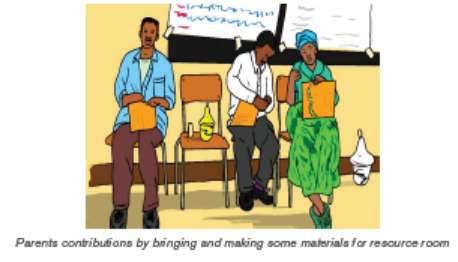
While the government provides a basic level of resources, additional resources
will be needed. The school should seek to create and collect additional
purposeful resources using local, cheap, innovative and responsive available
means. Schools need to use their local equipment, furniture, classrooms,
teachers and learners’ innovations and donations from the community. It is the
head teacher responsibility to take the lead with the creation and collection ofresources.
• Computer and Internet use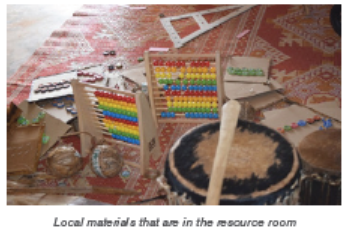
The resource room should be equipped with computers with Internet access.
This will enable learners to develop their academic, computer and Internet
skills. The resource room teachers should have Internet access that enables
them to use email and to share, collect and resource information.
During the planning, it is important that the resource room teacher develops a
system of planning that enables them to effectively teach their learners. This
planning must reflect the expectations of the learners’ IEP. It is also important
that the resource room teacher develops a system of record keeping that
enables them to effectively manage (teach, monitor and evaluate the academic
and social progress) of their learners. This information can then be put into the
learners’ IEP.
• Right of parents in resource room for children
Parents are considered to be full and equal members of the resource room
especially during the making of the IEP. Parents are crucial members of the
team because they have unique knowledge of their child’s strengths and
needs. In order to fully participate in developing their child’s IEP, parents must
be knowledgeable about their child’s specific disabilities and their rights.
Parents have the right to be involved in meetings that discuss the identification,evaluation, IEP development and educational placement of their children.

